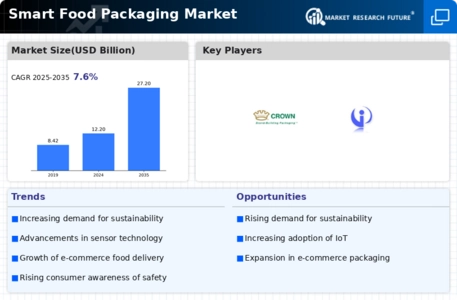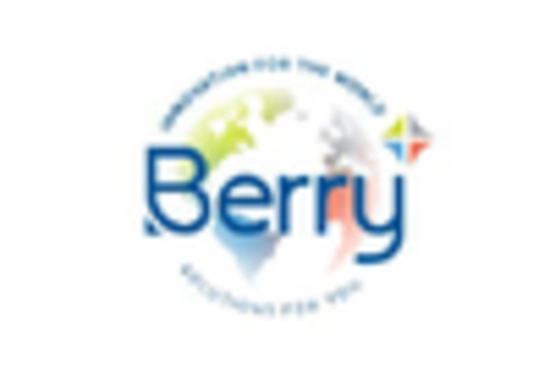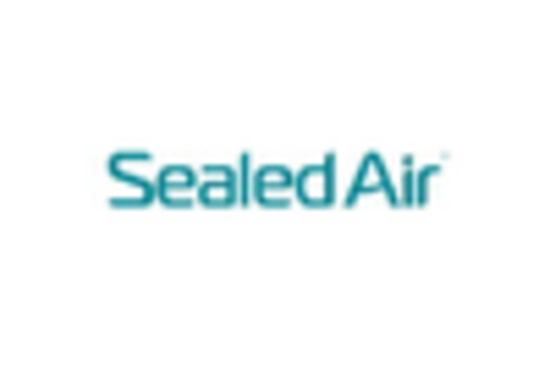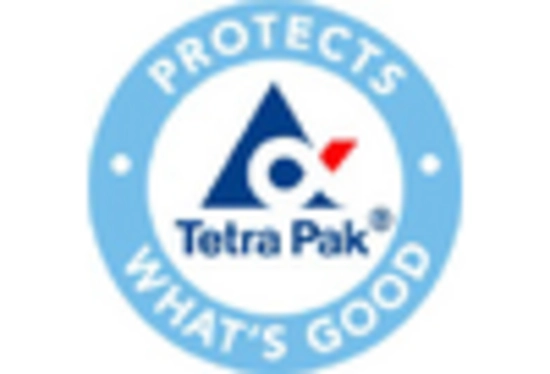Market Trends
Introduction
By 2025, the Smart Food Packaging market is expected to witness a considerable change, owing to the confluence of several macroeconomic factors. The major driving factor is the technological advancement, especially in the field of Internet of Things (IoT) and sensors. These advancements have made it possible to monitor the freshness and safety of food in real time. Along with this, the government regulations to reduce food wastage and promote sustainability are pushing the manufacturers to adopt smarter packaging solutions. Moreover, the changing customer preferences towards convenience and transparency are shaping the product offerings in the market. The above-mentioned trends are strategic for the companies, as they not only meet the customer preferences but also address the crucial concerns related to the environment and food safety. This will help them to stay ahead of the competition in the conscientious marketplace.
Top Trends
-
Sustainability and Eco-Friendly Materials
The move to more sustainable packaging is being driven by both regulations and consumer demand for more eco-friendly solutions. In particular, companies are increasingly using biodegradable and recyclable materials, and more than seventy per cent of consumers say they would be more likely to buy a brand that focuses on sustainable development. This trend is expected to significantly reduce plastic waste and affect both operational strategies and supply chain management. -
Smart Sensors and IoT Integration
Food is the most susceptible to contamination. The integration of IoT technology into food packaging can greatly improve the transparency of the supply chain and the safety of food. In addition, smart sensors can monitor the temperature and humidity of food, and the study shows that the rate of food poisoning is reduced by 30 percent. The use of this technology is expected to become the norm, and the food industry will have to build a digital platform and a big data analysis platform. -
Active Packaging Solutions
The active packaging which acts upon the products and thereby lengthens their life is gaining in popularity. Oxygen absorbers and moisture absorbers, for example, lengthen the life of the products and have been found in some cases to give an increase in freshness of up to 50%. This trend is driving manufacturers to new product development, which in turn is increasing their market share. -
Consumer-Centric Design
In the design of the packages, the main aim is to facilitate the life of the consumer. Recloseable and easy-to-open packages are becoming standard. Research shows that 65% of consumers are influenced by the package in their buying decisions. Brands are therefore rethinking their packaging strategies in order to enhance the experience of the consumers and brand loyalty. -
Blockchain for Traceability
The food supply chain is the most complex of all the supply chains. It must be able to be tracked from farm to table, and this is where the block chain comes in. In fact, companies that use the block chain claim that their customers’ trust in them has increased by 40 per cent. The trend is set to reshape supply chains, but it will require investment in technology and training. -
Personalization and Customization
The demand for individualized packaging is growing, and brands are offering individualized designs to appeal to consumers. Surveys have shown that up to 50% of consumers are more likely to buy products with individualized packaging. This trend is driving innovations in production processes, which may lead to higher operating costs, but also higher customer satisfaction. -
Regulatory Compliance and Safety Standards
A stricter attitude towards food safety and the use of packaging materials is changing the face of the industry. The need to comply with these regulations is becoming increasingly important. Non-compliance can result in heavy fines and the loss of a brand’s reputation. In order to meet these requirements, companies are investing in quality assurance processes, which in turn affects their operational performance and costs. -
Digital Printing Technology
In short, the quality of the printed products has improved considerably, and digital printing has made it possible to produce short-runs of high-quality packaging in an economical way. A study* shows that this technology makes it possible to design and manufacture products more quickly, with a reduction of up to 25 per cent in the time taken to produce them. This trend will continue, as more and more brands seek to differentiate themselves from their competitors. -
Health and Wellness Messaging
In this context, the importance of health-related packaging is growing, especially as consumers increasingly focus on health and well-being. In fact, research shows that 75 per cent of consumers read labels for health information. This trend is having an effect on the design of packaging and on marketing strategies, and nutritional information is being highlighted. -
E-commerce Packaging Solutions
The rise of e-commerce has given rise to the need for protective packaging. It is an innovation for which there is a great demand. Studies show that the level of customer satisfaction increases by 20 per cent when the packaging is improved. This trend is reshaping logistics and delivery strategies across the industry.
Conclusion: Navigating the Smart Food Packaging Landscape
The smart food packaging market is evolving and the competition is getting fiercer and fiercer. The market is being shared between the old and new players. Brand and sales are the main weapons of the old companies, and new entrants rely on technology and innovation to establish their position. In terms of geography, the demand for smart food packaging in North America and Europe is still high, driven by the government's regulatory requirements and consumers' demand for transparency and environmentalism. But the development trend is not obvious, and the competition will intensify. In order to achieve the goal of leading the industry, the key is to build a strong system that combines artificial intelligence, automation and the ability to change with the times. Strategic cooperation and investment in R & D are essential for companies to survive in this rapidly changing industry.

















Leave a Comment